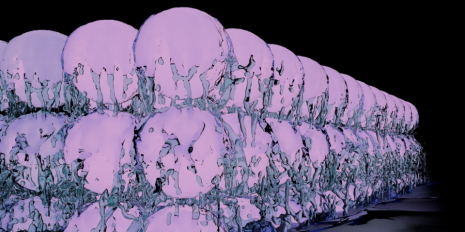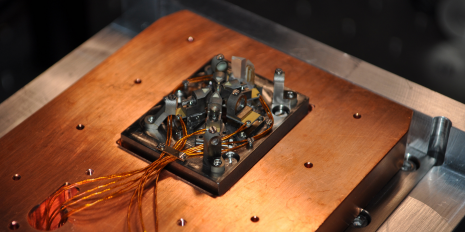

| Online: | |
| Visits: | |
| Stories: |

| Story Views | |
| Now: | |
| Last Hour: | |
| Last 24 Hours: | |
| Total: | |
Crystalline and Liquid at the Same Time
Solid, liquid or gas – we encounter these three clearly defined states of matter every day. It is difficult to imagine that substances could simultaneously exhibit properties of two of these states. Yet, precisely such a phenomenon is possible in the realm of quantum physics, where matter can display behaviours that seem mutually exclusive.
Image: ETH Zurich / Julian Léonard
Supersolidity is one example of such a paradoxical state. In a supersolid, atoms are arranged in a crystalline pattern while at the same time behaving like a superfluid, in which particles move without friction.
Until now, supersolidity was merely a theoretical construct. But in the latest issue of Nature, a group of researchers led by Tilman Esslinger, Professor of Quantum Optics at the Institute for Quantum Electronics, and Tobias Donner, Senior Scientist at the same institute, report the successful production of a supersolid state.
The researchers introduced a small amount of rubidium gas into a vacuum chamber and cooled it to a temperature of a few billionths of a kelvin above absolute zero, such that the atoms condensed into what is known as a Bose–Einstein condensate. This is a peculiar quantum-mechanical state that behaves like a superfluid.
Image: ETH Zurich
The researchers placed this condensate in a device with two intersecting optical resonance chambers, each consisting of two tiny opposing mirrors. The condensate was then illuminated with laser light, which was scattered into both of these two chambers. The combination of these two light fields in the resonance chambers caused the atoms in the condensate to adopt a regular, crystal-like structure. The condensate retained its superfluid properties – the atoms in the condensate were still able to flow without any energy input, at least in one direction, which is not possible in a “normal” solid.
“We were able to produce this special state in the lab thanks to a sophisticated set-up that allowed us to make the two resonance chambers identical for the atoms,” explains Esslinger.
With their experiment, the physicists in the team of Esslinger and Donner realised a concept theorised by scientists including British physicist David Thouless. In 1969, he postulated that a superfluid could also have a crystalline structure. Theoretical considerations led to the conclusion that this phenomenon could be most easily demonstrated with helium cooled to just a few kelvins above absolute zero. In 2004, a US group reported that they had found experimental evidence for such a state, but later attributed their findings to surface effects of helium. “Our work has now successfully implemented Thouless’s ideas,” explains Donner. “We didn’t use helium, however, but a Bose–Einstein condensate.”
A second, independent study on the same topic appears in the same issue of Nature: a group of researchers led by Wolfgang Ketterle at MIT announced last autumn – shortly after the researchers at ETH – that they had also succeeded in finding evidence of supersolidity, using a different experimental approach.
Contacts and sources:
Source: http://www.ineffableisland.com/2017/03/crystalline-and-liquid-at-same-time.html




